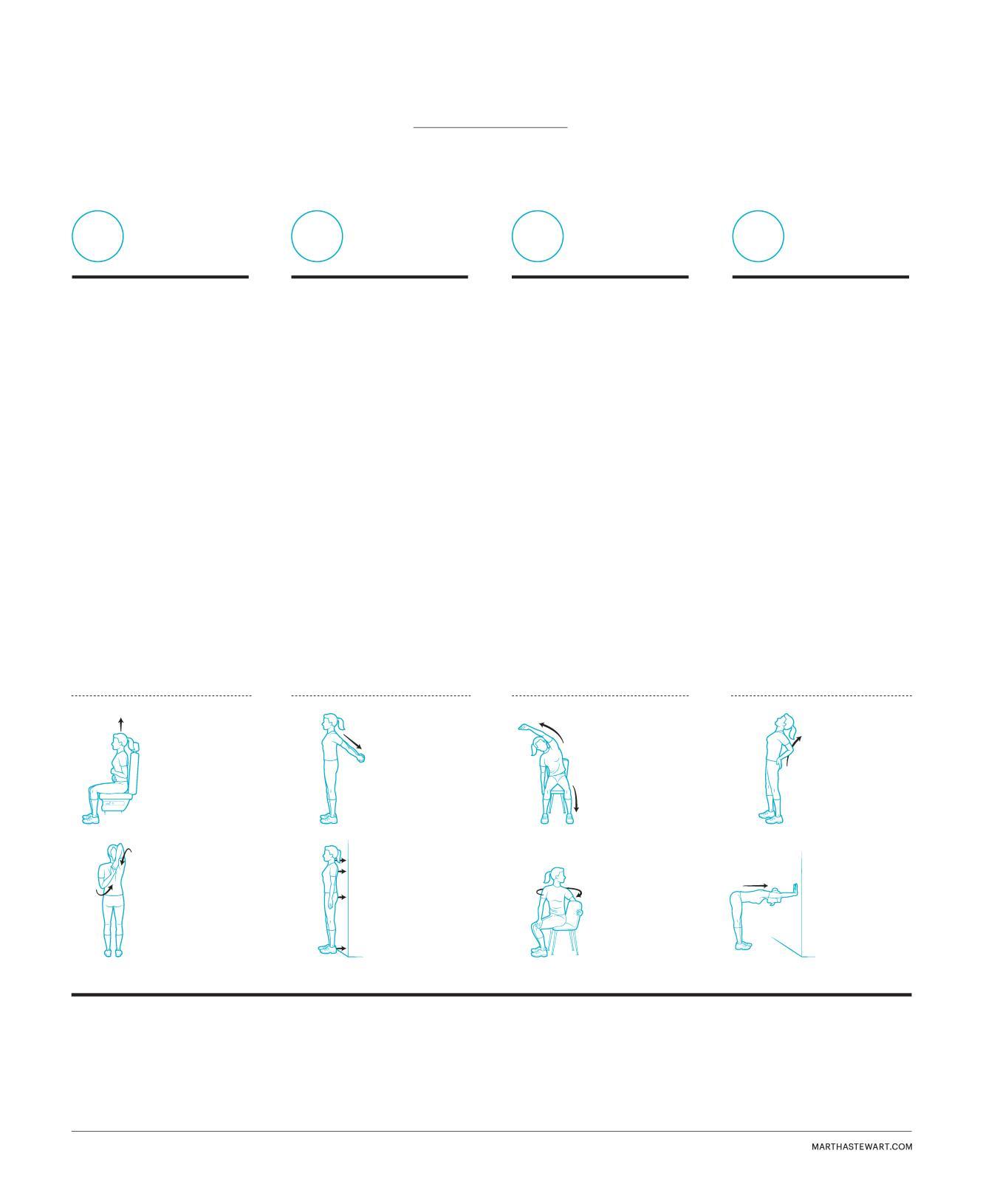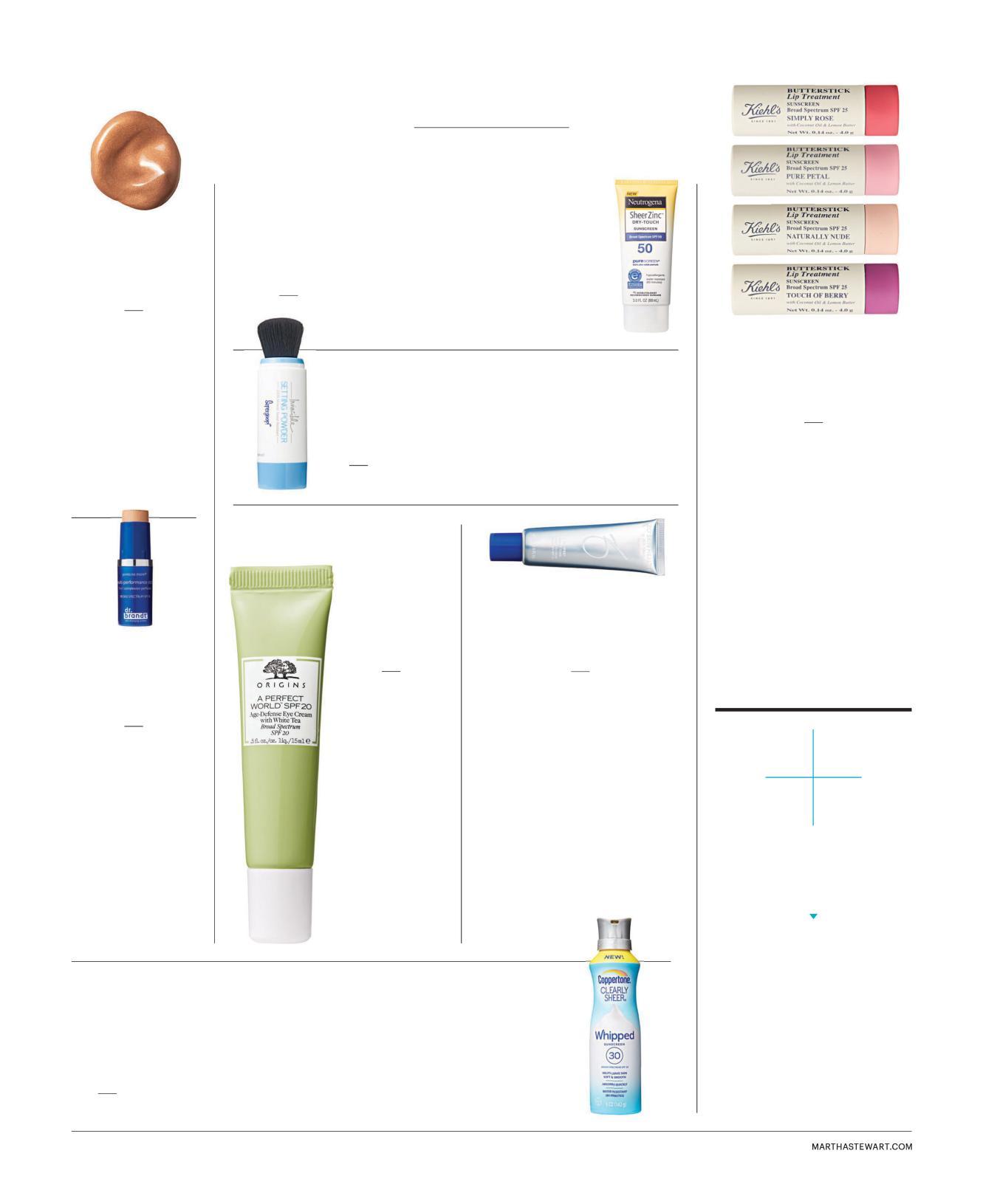
6 minute read
small business
Health
GOOD LIVING
Advertisement
THE PATH TO GOOD POSTURE
Healthy body alignment is a fundamental step toward feeling relaxed and looking lithe—and you don’t need a personal Pilates instructor to achieve it. Make a few minor adjustments to your daily routine, and start walking taller now.
TEXT BY KATE ROCKWOOD
IF YOU’RE BENDING FORWARD TO READ THIS, LOOK UP. Shift your head back in line with your shoulders, gently lower your ribs, and breathe. See? Good posture doesn’t just make you look better; it makes your whole body feel better. That’s because when your head, neck, and spine are properly positioned, the joints and muscles that support them aren’t strained, which translates into fewer body pains, headaches, and injuries— and more energy and ease of motion. Spend a couple of minutes each day doing these gentle exercises to stretch the tight muscles that tempt you to slouch, and tweak your surroundings to help you hold your head high. Before long, your body will fall in line naturally, and you’ll be floating through life.
7:00 A.M.
ROLLING OUT OF BED
If you often wake up with a kinked neck, lower back, or shoulder, your sleep position might be to blame. Side and stomach sleepers may contort their neck and shoulders, especially if their pillow is too big or too small, says Stacey Pierce-Talsma, D.O., chair of the osteopathic manipulative- medicine department at Touro University California, in Vallejo. Prevent this from happening by trying out a few pillows in different materials and thicknesses. “Your neck should be neutral, not forced too high or low,” Pierce-Talsma says. If you’re resting at an awkward angle, look for one that’s less lofty. To offset any lingering morning soreness, take a minute to stretch. “Warming up your spine muscles and increasing blood flow can quiet that stiffness,” says Julie Erickson, founder of Endurance Pilates and Yoga, in Boston.
1. Lie on your back. Stretch your arms and legs in opposite directions. Hold for 10 seconds. Repeat three times.
2. Stretch your right arm and left leg in opposite directions. Hold for 10 seconds. Switch and repeat with your other arm and leg. Repeat three times.
3. Climb onto your hands and knees. Inhale, and lift your head and tailbone. Then ex- hale, tuck your head, and round your spine. Re- peat three times.
Health
GOOD LIVING
8:45 A.M.
DRIVING YOUR CAR
“Many of us tend to collapse into our seats while driving, slumping our shoulders and shortening our abdominal muscles,” says Rebecca Seguin, an exercise physiologist and professor of public health at Cornell University, in Ithaca, New York. By the time you pull into the parking lot, you could be a puddle of bad posture. The fix: Before starting the car, sit very tall and adjust the rearview mirror accordingly. If you’re prone to slouching, you’ll have to angle it up. Boosting your core strength and opening your chest with the basic moves below can also help you combat the habit of hunching. (They’re helpful to do at a desk job, too.)

1. At red lights, lengthen your spine and contract your abs. Breathe normally. Hold for about 30 seconds, then rest for 30 seconds. Repeat.
2. After you park, bend your left arm behind you, palm up. Raise and bend your right arm; reach for your left hand. Hold for three breaths. Repeat on the other side. 12:30 P.M.
WAITING IN LINE
Idle time spent texting can give you a bad headache, maybe even a migraine. “We’re constantly looking down at our phones. Imagine how your wrists would feel if you held a bowling ball out in front of you all the time. That’s what your neck goes through,” says Noshir Mehta, D.M.D., a professor and former director of the Craniofacial Pain Center at Tufts University, in Boston. When your head tilts just 15 degrees, the pressure on your neck can more than double, a 2014 study in Surgical Technology International found. The resulting stiffness there creates major tension. Try holding your phone at eye height, or, better yet, put it away and sneak in some stretches.
1. Stand up straight. Join your palms behind you. Press your arms straight back. Hold for 10 seconds. Release. Repeat three times.
2. Stand against a wall with your bottom, heels, and shoulder blades touching it. Bring your chin back until your head touches too. Hold for 10 seconds. 3:00 P.M.
TALKING ON THE PHONE
Cradling the receiver during a conference call is more than just a pain in the neck, says Eric Alikpala, an exercise physiologist at Canyon Ranch, in Tucson, Arizona: It causes your upper back to crumple, tens- ing and tightening muscles around your rib cage called the intercostals —and sitting compounds the problem. Invest in a headset or use speakerphone, if possible; for calls that require looking at your computer screen (and for workday comfort in general), move your monitor closer to the edge of your desk and put a couple of books under it; that way, you won’t need to lean forward or look down to see. And whenever you can, stand up and do a quick side bend.
1. Spread your feet hip-width apart. Push your right foot down, and stretch your right arm up and over. Hold for 30 seconds. Repeat on the other side.
2. Sit with your feet flat on the floor. Twist to the left, rest- ing your right hand on your outer left thigh. Hold for three breaths. Repeat on the other side. 7:00 P.M.
COOKING DINNER
Prepping a meal at a too-high or too-low counter may strain your shoulders or neck and lower back, Seguin says; with your elbows bent at 90 degrees, it should be within inches of your hands. But you don’t have to renovate your kitchen to give your body a break: If the counter’s too low, stack a few cutting boards; if too high, try wearing clogs (they’re comfy and add a couple of inches). Every few minutes, step away for a five-second back bend. “It sounds like a small thing, but leaning backward at the lower back offsets all the forward hinging that creates postural imbalance,” Alikpala says. “You don’t have to try to win a limbo contest; just tilt enough to feel some relief.”
1. Spread your feet hip-width apart. Rest your palms on your lower back, and gently bend backward from there; gaze at the ceiling. Hold for five seconds.
2. Put your hands flat on a wall, shoulder-width apart. Walk your feet back, and lower your hands until you’re at a right angle. Hold for 30 seconds.
Get Aligned, Get a Lot Happier
It’s not an overpromise. Scientists say that proper posture can help you . . . BELIEVE IN YOURSELF
For a study in the European Journal of Social Psychology, researchers had students sit up tall or lean over, then asked them about their job prospects and personal traits. The tall ones had more confidence in their thoughts. IMPROVE YOUR MOOD
A 2015 study in Health Psychology found that participants who were randomly assigned to practice upright posture had higher self-esteem and were better at deflecting stress than those assigned to slump. REMEMBER THE GOOD STUFF
Researchers in San Francisco and Taiwan asked subjects to slouch or straighten up, then think of a positive memory; they found that the straight sitters had an easier time recalling one.










